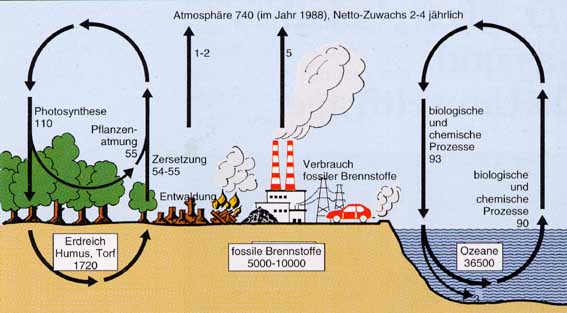Environment
CO2 in the air is one of the foundations of life on earth. The only problem is the rapid increase in this trace gas since the beginning of industrialisation.
The carbon cycle on earth

All figures in billion tonnes of carbon (1 t C = 3.7 t CO2)
There is currently a surplus of 7.4 - 14.8 gigatonnes (Gt) per year on the CO2 formation side due to human influence!
Essentially, two cycles are effective
| Biological cycle | Absorption and desorption of CO2 in the world's oceans |
| Plants convert CO2 into carbohydrates during photosynthesis. | The oceans play the largest role in nature's CO2 balance. |
| CO2 is released again during the respiration and decomposition of biomass. | According to the latest estimates, only 1 - 2 % of the total CO2 is found in the atmosphere. |
| Most of it is bound in the cold deep water of the oceans. Every year, around 11 Gt of CO2 is removed from the cycle by the transport of water from the surface to the depths. However, as the mixing of the oceans is a very slow process, the capacity to absorb additional CO2 is very limited. |
CO2 content and climate history
| 18,000 years ago (peak of the last ice age) |
200 ppm |
| around 1800 (pre-industrial period) |
280 ppm |
| 1950 | 310 ppm |
| at present | 350 ppm (rising) |
Since the last ice age, the CO2 content of the atmosphere and the mean surface temperature have been rising. What is the cause and what is the effect cannot yet be clearly proven.
It is to be feared that the exponential increase in CO2 production since industrialisation has favoured the so-called greenhouse effect:
Together with other trace gases, CO2 causes global warming of the earth with the often-discussed catastrophic effects on nature and thus also on humans (shifting climate zones, rising sea levels, increased tendency to storms, poor harvests, etc.).

